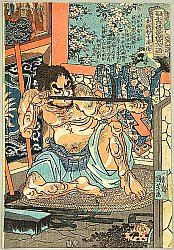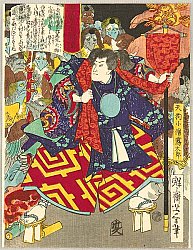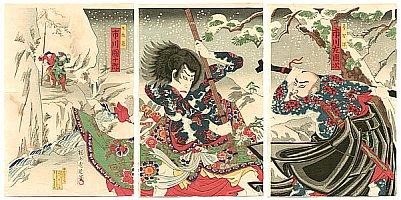Heroes of the SuikodenBlacksmith Toryo

Japanese History - more articles
Kuniyoshi Utagawa 1797-1861
copyright protected

Japanese History - more articles
Kuniyoshi Utagawa 1797-1861
copyright protected
The story of the 108 heroes of the Suikoden goes back to an old Chinese novel about 108 honorable bandits, some kind of Robin Hood gang. At the beginning of the 19th century it became very popular in Japan. And the suikoden heroes became one of the favorite subjects of Japanese prints.
The images on this page are link-sensitive and take you to other articles or web sites in which you might be interested. Shuihu Zhuan and the 108 Outlaws of the Water Margin
The original novel was written in the 14th century in China and was titled Shuihu Zhuan (Japanese: Suikoden). It tells the adventures of 108 rebel bandits under the leadership of the brave Song Jiang who fought against injustice by corrupt regional leaders and for the rights of the common people.The bandits lived in the marshes near the mountain of Liangshan. Therefore the story was published in the Western world under the title The Water Margin.
The rebels follow their own peer-group code of conduct. Comradeship and loyalty is high on the agenda. The novel is organized in chapters and tells the story in a way that reminds of today's TV soap operas.
Handsome Heroes of SuikodenTengu Kozo

artelino - Art auctions
Yoshitoshi Taiso 1839-1892
copyright protected
The Suikoden brigands fight for justice. But the way they pursue their goals makes a modern movie hero like Rambo look like a well-mannered student of jurisprudence. A Suikoden hero first decapitates his opponent with his sword and then asks questions - not the other way around. 
artelino - Art auctions
Yoshitoshi Taiso 1839-1892
copyright protected
The story of Shuihu Zhuan has two versions with very different endings. This can often be found for great Chinese or Japanese stories based on folk tales like for instance in the ghost story of Okiku. In one version the bandits and their boss join the imperial forces and from then on fight robbers and bandits in the name of law and order. Another version ends with the death of the gang members and their leader. The different versions are probably the result of censorship by the authorities.
It is assumed that the story had a background of real historical events dating from around 1120.
Suikoden and Japanese Tattoos
Portraits of the Suikoden Heroes

Japanese Prints - Intro
by Hokusai Katsushika 1760-1849
copyright protected
In 1805 the Japanese writer Takizawa Bakin undertook the task of a new translation and adaption of the story of the Chinese bandits as New Illustrated Edition of the Suikoden - Shinpen Suikogaden. The book was illustrated by the great Ukiyo-e master Hokusai Katsushika. 
Japanese Prints - Intro
by Hokusai Katsushika 1760-1849
copyright protected
The Japanese adaption became a huge success among the common urban population of the Edo period. It produced a kind of craze like the Beatlemania in the sixties. Everything connected with the Suikoden was suddenly iki - cool, trendy.
In the early 19th century the common Japanese people lived under prosperous economic circumstances, but also under a harsh rule by the powerful Shogunate dynasty of the Tokugawa clan. And the social order was codified in a system of inherited classes - the samurai class, the merchants, the craftsmen and the farmers. A commoner had hardly any chance to climb up the social ladder. No wonder that the average people adored the Suikoden who dared to challenge the ruling power.
The story of the Suikoden and the subsequent print series by Kuniyoshi was also the ignition powder for the fashion of Japanese body tattoos. Tattoos became popular among people of the lower classes like construction workers, prostitutes and the infamous fire wardens. The latter were admired by the public for their courage. But they had also a reputation of wild, drunken ruffians who could become more dangerous than the fires.
Suikoden Prints by Kuniyoshi and Yoshitoshi
In 1827 Kuniyoshi received a commission by the publisher Kagaya Kichibei for five designs of a planned series about the 108 Suikoden. According to today's art critics he then was the best print-maker of his time, but a destitute lad. He could hardly make a living with his print designs and the story goes that he had to repair and sell straw mats to survive.
The publication of the 108 Heroes of the Suikoden - Tsuzoku Suikoden goketsu hyakuhachinin no hitori - changed things drastically for Kuniyoshi. He became famous overnight and was commissioned the rest of the series, another 69 known prints. The commercial success of the series hit the roof top. Kuniyoshi had the luck to come out with the right theme at the right time. No more floor mats. Instead Kuniyoshi concentrated from now on for a few years on prints depicting fierce looking warriors. His contemporaries even nicknamed him the "warrior Kuniyoshi". Publishers kept commissioning prints with the popular Suikoden heroes over the decades to many Ukiyo-e artists. Many of them show Japanese heroes instead of the original Chinese characters.
Another famous Suikoden series was designed by the great Meiji artist Yoshitoshi. It was published in 1866/1867 and consists of 50 designs in Chuban size. The Yoshitoshi designs are pretty different from the Kuniyoshi prints - all rather somber with dark backgrounds and a lot of bizarre ghosts and monsters. Typical for Yoshitoshi who firmly believed in ghosts and spirits and who suffered from mental illness and depressions during certain periods of his life.
 More
More Contact
Contact Submit
Submit Premium
Premium
